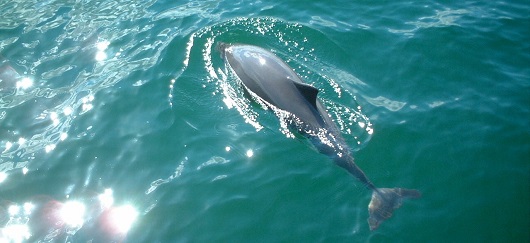St Andrews researchers help secure survival of the Baltic Sea harbour porpoise

Scientists, including researchers from the University of St Andrews, have spent two years deploying acoustic detectors throughout the Baltic Sea, even through solid ice, in a bid to protect one of the world’s most endangered populations of porpoise.
Their efforts have resulted in the world’s largest ever acoustic wildlife survey and persuaded the Swedish government to create a huge marine conservation area in the Baltic Proper for the harbour porpoise – the largest marine conservation area ever proposed by Sweden. This represents an important step towards securing the long-term survival of the Baltic Sea harbour porpoise.
The Baltic Sea harbour porpoise has a remaining population of around 500, a figure established by the University’s Centre for Research into Ecological and Environmental Modelling (CREEM), working as part of an international team of scientists from all the Baltic States, except Russia, on the project, called SAMBAH (Static Acoustic Monitoring of the Baltic Sea Harbour Porpoise).
The harbour porpoise is the only cetacean species resident in the Baltic Sea. There are three separate harbour porpoise populations in the Baltic Sea Region, but the one in the Baltic Proper has seen its population decrease dramatically since the mid-1900s.
Since porpoises in the Baltic Sea are now extremely scarce, they are virtually impossible to survey by traditional visual methods so the team of researchers used 300 fixed echolocation click detectors, spread in a systematic grid over the entire Baltic Sea. They collected data for two years, making this the largest acoustic survey of wildlife ever undertaken.
CREEM then used advanced statistical algorithms to convert the click data into numbers of porpoises, and worked with the research team to create distribution maps identifying where different parts of the populations live.

Dr Len Thomas of the School of Mathematics and Statistics at the University, and Director of CREEM, said: “This is the first survey designed from the ground up to estimate population size from acoustics. I pay tribute to the field teams, who went out in all conditions year-round, even drilling through sea ice, to deploy and service the acoustic detectors.
“Our analysis shows that a small population of ‘true’ Baltic porpoise remain, and it is pleasing to see the Swedish government take positive steps to protect them.”
As a result, the project concluded that there are only around 500 of the Baltic Proper porpoises (those living in the Baltic Sea Proper) remaining and, in consequence, the Swedish government has designated a large marine Natura 2000 area in the central Baltic for them.
Pending final approval by an EU expert forum, this area will provide urgently needed protection for the porpoises.
Covering more than 1 million hectares, this is the largest marine area ever proposed by Sweden as a Natura 2000 area and includes the major part of the most important breeding ground of the endangered population.
SAMBAH was an international project, funded under the EU LIFE programme, with the ultimate aim of securing conservation of the critically-endangered Baltic population.
Natura 2000 is a network of protected nature reserves in the EU.

Image captions
Top and news page: Baltic Sea harbour porpoise, Signe Sveegaard, DK
This page middle left: map shows the new Natura 2000 network of protected nature reserves in central Baltic Proper designated for the harbour porpoise by the Swedish Government.
This page middle right: map shows porpoise summer distribution, based on the probability of detecting porpoises with the click detectors used in SAMBAH. Black dots are detector positions with and white positions without detections. Dark blue is low probability, light blue higher probability; white areas were not surveyed.
This page bottom: LIFE, SAMBAH and Natura 2000 logos.
Issued by the University of St Andrews Communications Office, contactable on 01334 467310/2530 or [email protected].
Category Research